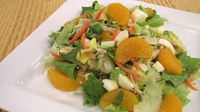Prairie Fare: Are You Taking Steps to Ensure Safe Fruits and Vegetables in Your Kitchen?
(Click an image below to view a high-resolution image that can be downloaded)
By Julie Garden-Robinson, Food and Nutrition Specialist
NDSU Extension Service
Are the cucumbers at the store safe? Have any recent foodborne illness outbreaks occurred with spinach, peppers or lettuce?
Lately, you might have heard or read about a recall of cucumbers imported from Mexico that reached various U.S. restaurants and retail stores. At the time of this column, 341 people in 30 states were sickened and two deaths were linked to cucumbers contaminated with Salmonella poona.
This strain of bacteria can cause vomiting, nausea, diarrhea and fever, and the symptoms may appear within three days of eating the food. It is especially hazardous to young children, older adults and people with a compromised immune system.
This recall does not mean that all cucumbers could make you ill, but you should not consume the recalled food.
For nutrition educators who promote eating more fruits and vegetables, foodborne illness outbreaks linked to fresh produce can make our jobs a little tricky. Depending on what is going on in the news, people might give you a leery look when you suggest they have a spinach salad or add some sliced cucumbers or peppers to their sandwich.
Adults, on average, need about 4.5 cups of fruits and vegetables to meet the daily recommendation. Fruits and vegetables provide vitamins A and C, along with fiber and antioxidants linked to health benefits. Eating more fruits and vegetables may reduce your risk of getting chronic diseases such as cancer or heart disease.
However, we need to handle fruits and vegetables safely so we get the benefits without the flulike or worse symptoms.
How do “germs” get on the vegetables or fruits, anyway? Harmful bacteria can be in the soil or in the water used to water the produce. Bacteria and other organisms can hitch a ride on equipment such as knives, on produce-handlers’ hands or the packing containers used to ship the vegetables. Investigating the source of the problem sometimes is very complicated.
The Food Safety Modernization Act was signed into law in 2011 to help ensure food safety. Some businesses will have to be compliant with the updated approach beginning in 2016. However, no matter what growers and food processors do, consumers also have a major responsibility in keeping food safe for themselves, their families and friends.
Even if the growers and processors do all the right steps, contamination can happen in your grocery cart, in your car or in your refrigerator.
The Food and Drug Administration has provided several tips for keeping fruits and vegetables safe, which I have arranged into questions for you to ask yourself. If you answer “yes” to these questions, you are taking steps to keep fruits and vegetables safe.
- Do you purchase produce that is not bruised or damaged? Fresh produce does not have to be “picture-perfect” in size or color, but remember that bacteria and other organisms often thrive in the bruised areas.
- When you purchase precut produce, do you choose items that are in the refrigerator section? If the cut produce is not in the refrigerator section, do you choose precut produce in containers surrounded by ice?
- At the grocery store, do you separate fresh produce from fresh meat, seafood or poultry? Juices from meat can contaminate your produce.
- At home, is your refrigerator set to maintain your food at 40 degrees or below? If you do not have a thermometer in your refrigerator, you might want to purchase a portable one.
- At home, do you keep precut produce in the refrigerator? Precut produce is perishable. Whole fruit, such as apples, are safe in a bowl on your counter.
- Do you always wash your hands with soap and water for at least 20 seconds before beginning food preparation? Hand washing plays a valuable role in keeping you healthy, too.
- When preparing food, do you take steps to avoid cross-contamination? Be sure that you wash cutting boards and knives thoroughly. Even better, have a dedicated cutting board for cutting produce. Many restaurants use yellow cutting boards for chicken, red for meat, green for produce, etc.
- Do you scrub and rinse firm produce such as cantaloupe and cucumbers with a clean produce brush?
- Do you eat prewashed salad greens right out of the bag? If you answered “yes,” that’s OK. If the package says the lettuce or other food is “ready to eat,” you do not need to rewash it. If you prefer to rewash, remember to avoid cross-contamination. In fact, have a good-sized portion of salad because dark green, leafy vegetables are healthful foods.
Here’s a recipe in which you could incorporate some fresh produce.
Asian-style Cobb Salad
5 c. chopped romaine lettuce (or your favorite lettuce)
1 (11-ounce) can mandarin oranges in light syrup, drained
1/3 c. cooked chicken, shredded
1/3 c. grated carrots
1 avocado, halved, seeded, peeled and diced
2 hard-cooked eggs, diced
1/4 c. green onions, sliced
Sesame Vinaigrette
1/4 c. plus 2 Tbsp. rice wine vinegar
1 clove garlic
1 Tbsp. sesame oil
1 Tbsp. sugar
1 tsp. ground ginger
1 tsp. soy sauce
Cook chicken or use leftover grilled or roasted chicken. To cook eggs, place in a small saucepan with cold water. Heat water just until boiling. Remove from heat and cover; let stand for 12 minutes. Drain water and eggs into a colander. Rinse eggs with cold water to stop cooking. Prepare Sesame Vinaigrette by whisking together all ingredients in a small bowl; set aside. Assemble salad by placing greens in a large bowl; top with mandarin oranges, chicken, carrots, avocado, eggs and green onion. Serve immediately with Sesame Vinaigrette.
Makes four servings. Each serving has 250 calories, 14 grams (g) fat, 8 g protein, 26 g carbohydrate, 5 g fiber and 160 milligrams sodium.
(Julie Garden-Robinson, Ph.D., R.D., L.R.D., is a North Dakota State University Extension Service food and nutrition specialist and professor in the Department of Health, Nutrition and Exercise Sciences.)
NDSU Agriculture Communication - Sept. 17, 2015
| Source: | Julie Garden-Robinson, (701) 231-7187, julie.garden-robinson@ndsu.edu: |
|---|---|
| Editor: | Ellen Crawford, (701) 231-5391, ellen.crawford@ndsu.edu |



